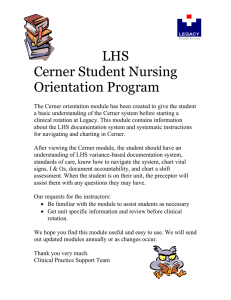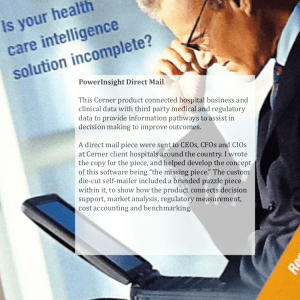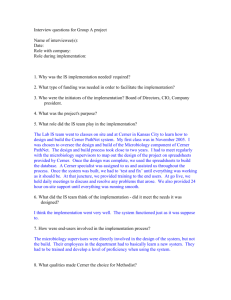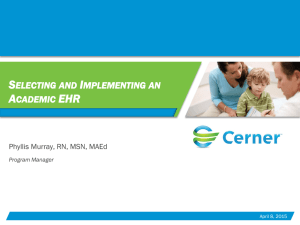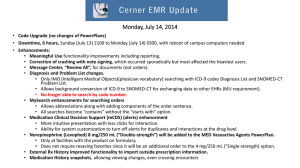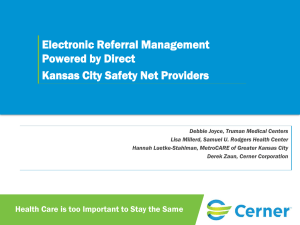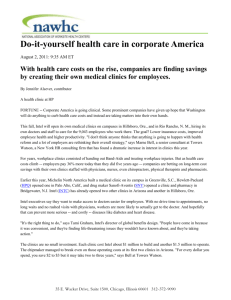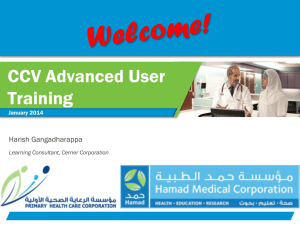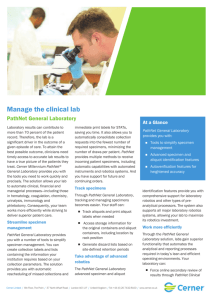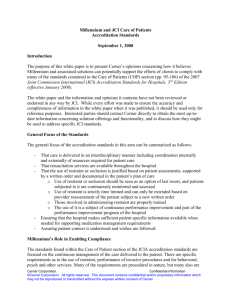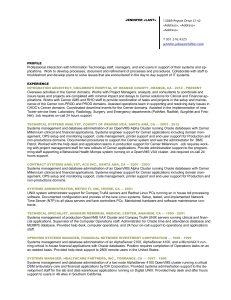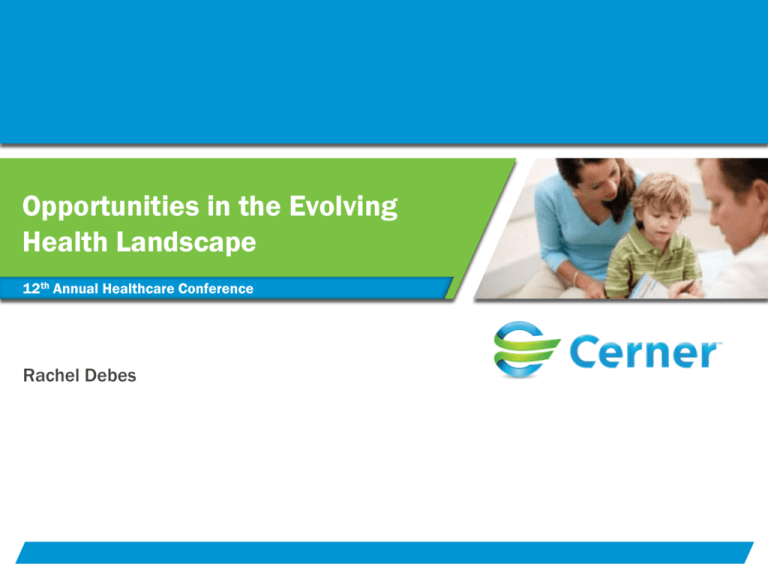
Opportunities in the Evolving
Health Landscape
12th Annual Healthcare Conference
Rachel Debes
Two Factors are Driving the Market Opportunity
Digitization of Healthcare:
Resulting in the proliferation of Electronic Medical Records
Enabling the interoperability of data
Promoting the information-based management of care and
Encouraging health of communities
Emergence of the Accountability Framework
Risk management is shifting from insurers to providers
Accountable Care Organizations (and their variants) are here to stay
Shift from Safety and Quality to Outcomes and Value
Big Data and Analytics will be the next foundation system
© 2011 Cerner Corporation. All rights reserved. This document contains Cerner confidential and/or proprietary information which may not be reproduced or transmitted without the express written consent of Cerner.
2
What’s Required to manage in the new framework?
Strong EHR
Foundation
Health
Information
Exchange
Data
Management
& Analytics
Care
Management
Patient
Engagement
Aligning Persons, Payers, and Providers
Driving Accountability for Outcomes and Value
© 2011 Cerner Corporation. All rights reserved. This document contains Cerner confidential and/or proprietary information which may not be reproduced or transmitted without the express written consent of Cerner.
3
Big Data Tools to Inform Care:
Health Facts
Health Facts
Multi-client data warehouse with available information
from 2000-present
35 million patients (currently US only)
Data from 4 major areas
Pharmacy
Labs
Billing/Administrative
Physiologic measures
Integrating predictive models will allow for individuallytailored real-time interventions
© 2011 Cerner Corporation. All rights reserved. This document contains Cerner confidential and/or proprietary information which may not be reproduced or transmitted without the express written consent of Cerner.
5
Managing Diabetes with Predictive Modeling
Utilizing Large Databases to Build New Content
©©2011
CernerCorporation.
Corporation.
All rights
reserved.
This document
Cerner confidential
and/or
proprietary
information
which mayornot
be reproduced
or transmitted
without
express written consent of Cerner.
2011 Cerner
All rights
reserved.
This document
contains contains
Cerner confidential
and/or proprietary
information
which
may not be reproduced
transmitted
without the
express written
consentthe
of Cerner.
6
Diabetes Potentially Avoidable Complication (PAC)
The DM PAC model is built using analysis of clinical
data from Health Facts® observational data set
Able to leverage hundreds of data inputs to derive the model
Population of over 200,000 diabetics identified to build and
validate the algorithm
Output: Individualized predictive model to better manage
disease
• Help to focus efforts on the behaviors that will have the biggest
return on investment
• Small steps for the patient, targeted points for the provider
Once a model has been externally validated
(prospectively) in clinical setting, it can be utilized to
inform and guide both clinicians and consumers on
potential complications
© 2011 Cerner Corporation. All rights reserved. This document contains Cerner confidential and/or proprietary information which may not be reproduced or transmitted without the express written consent of Cerner.
7
© 2011 Cerner Corporation. All rights reserved. This document contains Cerner confidential and/or proprietary information which may not be reproduced or transmitted without the express written consent of Cerner.
8
Case for Prevention
© 2011 Cerner Corporation. All rights reserved. This document contains Cerner confidential and/or proprietary information which may not be reproduced or transmitted without the express written consent of Cerner.
9
Condition Prospectus – Cost and Risk Segmentation
10
Future Directions
Make patients more engaged in wellness
Alerts and predictive models
Personal health records
Increased interoperability
Health Information Exchanges
Mobilizing healthcare information electronically across organizations
Leads to increased patient wellness, reduced provider spend
© 2011 Cerner Corporation. All rights reserved. This document contains Cerner confidential and/or proprietary information which may not be reproduced or transmitted without the express written consent of Cerner.
11

